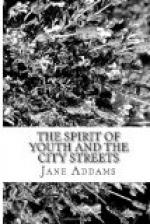We allow a great deal of this precious stuff—this Welt-Schmerz of which each generation has need—not only to go unutilized, but to work havoc among the young people themselves. One of the saddest illustrations of this, in my personal knowledge, was that of a young Russian girl who lived with a group of her compatriots on the west side of Chicago. She recently committed suicide at the same time that several others in the group tried it and failed. One of these latter, who afterwards talked freely of the motives which led her to this act, said that there were no great issues at stake in this country; that America was wholly commercial in its interests and absorbed in money making; that Americans were not held together by any historic bonds nor great mutual hopes, and were totally ignorant of the stirring social and philosophic movements of Europe; that her life here had been a long, dreary, economic struggle, unrelieved by any of the higher interests; that she was tired of getting seventy-five cents for trimming a hat that sold for twelve dollars and was to be put upon the empty head of some one who had no concern for the welfare of the woman who made it. The statement doubtless reflected something of “The Sorrows of Werther,” but the entire tone was nobler and more highly socialized.
It is difficult to illustrate what might be accomplished by reducing to action the ardor of those youths who so bitterly arraign our present industrial order. While no part of the social system can be changed rapidly, we would all admit that the present industrial arrangements in America might be vastly improved and that we are failing to meet the requirements of our industrial life with courage and success simply because we do not realize that unless we establish that humane legislation which has its roots in a consideration for human life, our industrialism itself will suffer from inbreeding, growing ever more unrestrained and ruthless. It would seem obvious that in order to secure relief in a community dominated by industrial ideals, an appeal must be made to the old spiritual sanctions for human conduct, that we must reach motives more substantial and enduring than the mere fleeting experiences of one phase of modern industry which vainly imagines that its growth would be curtailed if the welfare of its employees were guarded by the state. It would be an interesting attempt to turn that youthful enthusiasm to the aid of one of the most conservative of the present social efforts,




